Review of: Overdose: Heartbreak and Hope in Canada’s Opioid Crisis
Author: Benjamin Perrin
Publisher: Penguin Canada, 2020
Benjamin Perrin’s third book, Overdose, is nominally about the increase in overdose-related deaths brought on by powerful synthetic opioids such as fentanyl in British Columbia and elsewhere. In truth, however, it serves primarily to chronicle the author’s own conversion, from tough-on-crime conservative and chief justice advisor to former prime minister Stephen Harper, to advocate for what he calls “compassionate” methods of dealing with drug abuse—i.e., “safe injection” sites and “safe supply” programs. The book is not shy about this fact. Indeed, it even opens with Perrin affirming that he had once been the type to vote for the Conservative Party, no matter what, and closes with a call for readers to share his new beliefs as widely as possible.
The impulse to convert others likely explains why Perrin mailed a copy of Overdose to my office in the aftermath of a brief social media exchange. Probably, he hoped that I would be swayed by the book’s narrative, which is designed to impress upon the reader the sense that opioid overdose deaths constitute an emergency authorizing virtually any public policy response. As the author attempts to relate through a series of overdose anecdotes and interviews with law enforcement agents and social activists, the dramatic increase in deaths brought on by synthetic opioids has rendered the traditional prohibitionist approach to drugs futile—though Perrin now also believes that this model, which as he puts it frames drug use as a moral issue rather than a medical one, was fundamentally misguided from the outset.
Unfortunately, the book offers very little to surprise the reader who is already familiar with the arguments of drug policy activists. If one has already rejected such views, for example, because they neglect the social costs of rampant, open-air drug abuse, then dismissing the conclusions impressed by Overdose follows as a matter of course. Vancouver’s Downtown Eastside may be squalid, but for Perrin, this appears to only present a problem for those who live there, and not for the broader community. In the author’s telling, these conditions further amount to a sort of inevitability that we can do little to remedy. No doubt it would be better if the individuals in question simply stopped using or reduced their use. But there are lives at stake and they are powerless in the face of their compulsions. A compassionate approach therefore requires that we prevent people from dying and possibly manage the symptoms of their condition, and possibly, eventually curb consumption in some cases.
That said, reading Overdose is certainly not a waste of time. For one, the book has a few genuinely helpful chapters, in which Perrin pulls back from proselytizing and adopts a less heavy-handed public policy lens. In one such chapter, he provides a technical overview of the threat posed by synthetic opioids and the various responses available. The author’s analysis here seems to reveal that the core issue, from a pure mortality perspective, is one of inconsistent dosing by those who refine pure fentanyl into drugs for street consumption. Some people are getting fentanyl when they mean to consume something else, but quite often those who are overdosing are getting exactly what they want. So much for the “contaminated” or “toxic” drug supply.
More useful still are the book’s insights into how someone like Perrin came to be converted to “compassionate” drug policy. Reading through Overdose, it was striking how much his new beliefs remain consistent with those he now intends to disclaim. That Perrin once understood drug use as a moral issue—in which drug users assume consequences entirely of their own choosing—is precisely why he can now claim that it is a purely medical one—i.e., because drug use results from addiction, and addiction renders those who use drugs incapable of choice and thus incapable of blame. Both positions assume that individuals can only bear responsibility for choices they are fully free to make. Both also de-emphasize the socially destructive effects of drug use, and therefore the profound injustice that it inflicts on others. That we should help those who suffer from addiction is obvious, but Perrin would have us believe that “compassion” requires that we enable behaviour that is both self- and socially destructive while requiring that others bear its costs without complaint.

This same continuity of thought appears in Perrin’s understanding of the criminal justice system, which he suggests is aimed at influencing the choices people make—and not, for instance, ensuring the public order required for human flourishing. On this essentially behaviourist view, a criminal prohibition that does not deter those who suffer from addiction is “pointless”: it is not an “evidence-based” policy. In fact, if those who use drugs are simply responding to “trauma”, and if one can only be responsible for what one fully chooses to do, then criminal prohibition amounts to a form of unjust discrimination. As the author repeatedly asserts, criminal prohibitions are a source of stigma that entices drug users to find newer, riskier ways of getting high. As is typical of drug policy activists, he believes that stigma is the reason that overdoses continue to occur notwithstanding the compassionate policies already in place in Vancouver and elsewhere. Stigma is not valuable as a means of marking destructive behaviour as such. Stigma must be stigmatized.
From my vantage point, passages in which Perrin compares drug prohibition to the traditional Indian caste system, or in which he insinuates that the prohibition of drug use is equivalent to race segregation by quoting Martin Luther King Jr., only served to confirm the absurdity of his overall position. And yet, such comparisons are difficult to avoid once one accepts Perrin’s framing. On such a view, prohibitions on drug use really are unjust laws that prevent drug users from receiving the “care” they need. And these laws are particularly unjust to the extent that they create stigma around drug use. Never mind that there are cogent reasons to mark drug use with opprobrium and those who engage in it with at least some level of disapproval. Such a view of the criminal justice system is already outside the bounds of Perrin’s understanding of its role.
Perrin’s purportedly evidence-based perspective thus masks a set of ideological commitments that are in surprising continuity with the beliefs he is now intent on disclaiming. The end result is an assertion of the primacy of bare life not just over the social consequences of addiction, but also over individual dignity. It is ironic, then, that Perrin complains about the unintended consequences of COVID restrictions in an afterword included in the latest edition of the book. Indeed, it is hard not to see in his endorsement of safe injection sites and safe supply programs the same fetishism for raw numbers that informed much of the pandemic response. Deaths are easily tracked. The social consequences of drug abuse and the quality of life experienced by those who abuse opiates are not. The conversion journey recounted in Overdose remains blind to these broader realities. But perhaps the author’s journey is not yet complete.
Recommended for You

The Notebook by Theo Argitis: Mark Carney’s first major tests

‘Those deficits are almost surely going to rise’: Trevor Tombe on the fiscal challenges facing the Carney government

‘Our role is to ask uncomfortable questions’: The Full Press on why transgender issues are the third rail of Canadian journalism

Need to Know: Progressive politicians’ public safety problem



